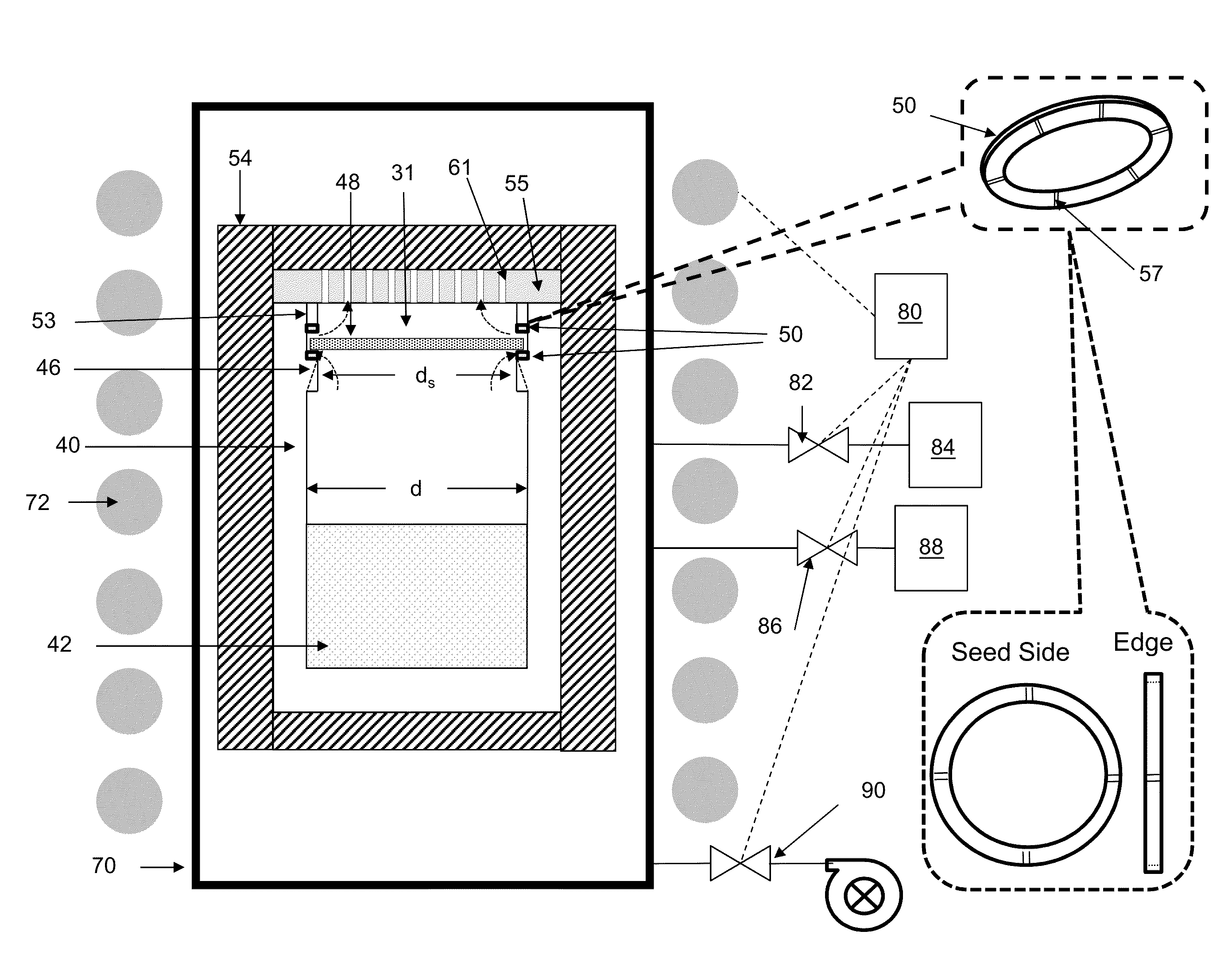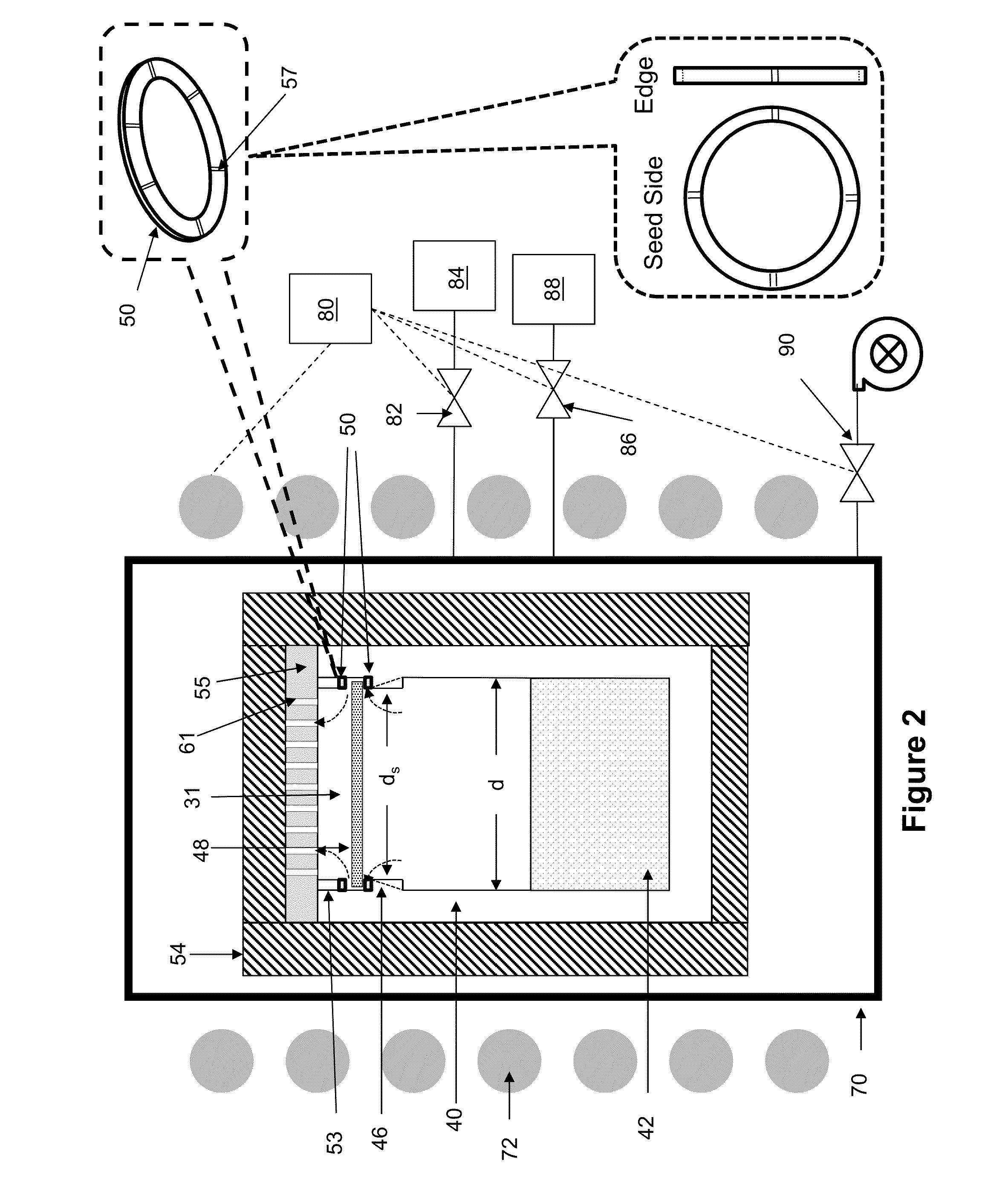Growth of SiC by sublimation is very challenging.
Temperatures in excess of 2,000° C. are required to generate vapor
stream of Si / C species by sublimation, which places great limitations on the reaction
cell components and the furnace design.
While this appears simple in concept, in practice the growth of SiC is very complicated and recognized by those who practice as very difficult to perform.
Stresses arising from temperature gradients and
thermal expansion mismatch and imparted to the seed and the
crystal during growth can result in formation of dislocations.
Deviation of the
stoichiometry in the sublimation vapor
stream from that needed to form SiC can result in unstable polytype growth—in turn leading to polytype inclusions in the grown
crystal, which lead to
dislocation formation at the polytype boundaries.
The large count of dislocations makes it very impractical to count every single one, especially as today inspections can be required on sections greater than or equal to the equivalent of 100 mm
diameter circles.
However, incorrect sampling methods can lead to errors in the
estimation of the
dislocation concentration associated with larger crystals.
In most reports, the details of the sampling method are not provided, so replication of reported results can often be difficult, if not impossible.
Scientists experienced in
solid state
physics and
semiconductor devices know that dislocations result in device performance below the theoretical properties of the material.
When the tilt is not adequate, the CVD process will produce three dimensional defects on the surface, and such defects will result in non-operational semiconductor devices.
Defects in SiC are known to limit or destroy operation of semiconductor devices formed over the defects.
Neudeck and Powell reported that
hollow core screw dislocations (micropipes) severely limited
voltage blocking performance in SiC diodes (P. G. Neudeck and J. A. Powell, IEEE
Electron Device Letters, vol.
Modern technology for growth of 4H—SiC crystals has not been successful to develop a commercial method for a
crystal growth process that allows simultaneous control over the
gamut of dislocation types.
Various methods disclosed in the prior art are often lacking detail regarding the specific steps employed in the
crystal growth or the methods employed to assess the concentration of defects and demonstrate
repeatability.
However, the act of mounting the seed to the reaction
cell lid or seed holder can lead to undesirable effects during
crystal growth.
For example, during the mounting process,
scratching of the coated seed back may occur.
In addition, a void may be created between the seed and reaction
cell ceiling interface during the mounting process.
Such occurrences may exacerbate formation of
evaporation cavities of the seed backside, resulting in defect formation.
Moreover, differences in
thermal expansion between the seed and lid can cause stresses in the seed.
However, because the reaction cell is typically made from a different material than the
seed crystal, the rigid attachment methods often create stresses in the crystal during growth.
For example, when the seeds are mounted to the reaction cell or lid using an
adhesive, it is possible for the seed to be bent during the mounting process, which results in undesirable stress in the crystal.
However, contact between the crystal and holder is such that stress on the crystal may still occur during growth.
Moreover, if the lid's surface is not smooth and flat, it will create pressure points on the back surface of the seed, thereby generating strains in the seed.
Even if the lid is perfectly flat such that the seed perfectly contacts the lid, when seed touches the lid it will cool the backside of the seed, causing it to bow away from the lid and the seal will be broken.
Also, the bowing will cause the crystal to be in stress, leading to defects in the growing crystal.
There are other problems with the approach disclosed in the JP 2011-20860.
For example, when the seed is elevated due to pressure differential, it blocks gas flow out of the
crucible, thus leading to increased pressure and temperature inside the
crucible.
Also, as the crystal grows it gets heavier and at some point will be too heavy for the pressure differential to maintain it against the lid, at which point the crystal would drop, leading to sudden change in the temperature of the crystal and due to resumed flow of gas out of the
crucible, reduced pressure and temperature inside the crucible.
 Login to View More
Login to View More 


